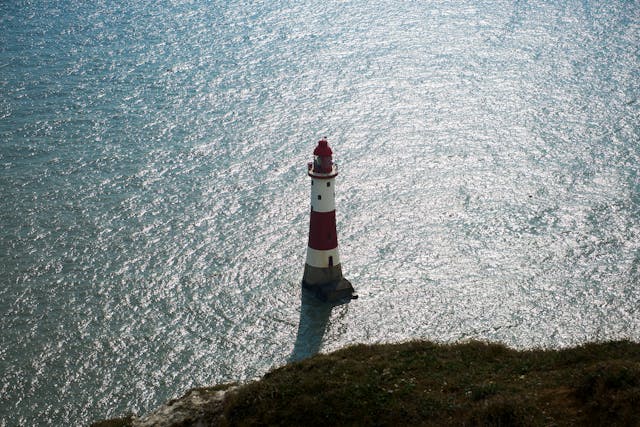Global positioning systems have significantly reduced the need for human lightkeepers, but some lighthouses still exist and are manned.
This article explores various activities of the lighthouse keeper profession. With technology and automation increasingly taking over, the prospects for the light housekeeper profession appear limited today. But it was an interesting professional role in the pages of history, which means it surely deserves a coverage, which we are aiming to do in this article.
A brief history of lighthouses and lightkeepers
Lighthouses have been around for centuries, with the earliest known lighthouse dating back to the third century B.C. in Egypt. These structures were built as navigational aids, guiding seafarers safely to their destinations.
The first lighthouse in the United States was built in Boston in 1716. In the early days, lighthouses were usually lit with candles, oil lamps, or gas lamps. The lightkeepers, who were responsible for maintaining the light and the equipment, also lived in the lighthouse and were on duty 24 hours a day. They kept watch for approaching ships, tended to the light, and maintained the lighthouse and its equipment.
Importance of lighthouses in navigation
Lighthouses have played a crucial role in navigation for centuries. They were built as aids to help mariners navigate safely through treacherous waters and guide them to their destination. In the past, when navigation technology was limited, lighthouses were the only reliable way for sailors to navigate the coastline.
Lighthouses provided a visual reference point for navigation and warned of the dangers of rocky shorelines and shallow waters. Today, although modern navigation technology has largely replaced the need for lighthouses, they still serve an important role in maritime safety, particularly in remote or hazardous areas where electronic navigation aids may not be available or reliable. Additionally, lighthouses often have historical and cultural significance and are treasured landmarks that serve as symbols of maritime heritage.
Duties and responsibilities of a lighthouse keeper
Lighthouse keepers have a wide range of duties and responsibilities to ensure the safe and efficient operation of the lighthouse and to assist seafarers in navigation.
Please find below the core duties and responsibilities performed in this professional role.
Maintenance of Lighthouse and Equipment: One of the primary responsibilities of a lightkeeper is to ensure that the lighthouse and its equipment are in good working order. This includes regularly inspecting and maintaining the light, lens, and other navigational aids, as well as the foghorn and other safety equipment.
Navigation Assistance: Lightkeepers monitor weather conditions and provide navigation warnings to vessels in the vicinity. The professionals also provide directions to vessels in distress, guiding them safely to the nearest port.
Record-keeping: Lightkeepers are responsible for maintaining records of vessel traffic, weather patterns, and other important information related to the operation of the lighthouse. They complete and submit reports on time to ensure that this information is shared with the appropriate authorities.
Communication: Lightkeepers must have excellent communication skills, as they often need to communicate with vessel crews, other lightkeepers, and maritime authorities. They may also be responsible for maintaining the lighthouse’s radio and telecommunication equipment.
Emergency Response: In the event of an emergency, like a storm or other natural disaster, lightkeepers are responsible for taking appropriate measures to ensure the safety of themselves, their colleagues, and any visitors to the lighthouse.
Qualifications and training of a lighthouse keeper
Education: A high school diploma or equivalent is typically required to become a lighthouse keeper.
Experience: Experience in maritime operations, such as sailing or working on a boat, may be beneficial.
Physical fitness: Lighthouse keepers need to be physically fit and able to climb stairs, ladders, and other equipment. They should also be able to lift heavy objects.
Communication skills: Lighthouse keepers need to be able to communicate effectively with other workers and with ships and vessels that may be in the area.
Navigation skills: A good understanding of navigation and maritime regulations is essential.
Training: Lighthousekeepers typically receive on-the-job training from experienced personnel, and they may also need to complete specialized training in areas such as fire safety, first aid, and emergency response.
Certifications: Depending on the country and the organization that employs them, lighthouse keepers may need to obtain specific certifications or licenses to work professionally.
The future of the lighthouse keeper profession
The future of the lighthouse keeper profession is uncertain, as the use of lighthouses for navigation has declined with the advancement of technology.
In many countries, automated lighthouses have replaced manned lighthouses, and this trend is expected to continue. However, there are still some regions where manned lighthouses are necessary due to factors such as weather conditions, geography, and the volume of maritime traffic.
One potential future for the profession is a shift towards a more multifaceted role. Lighthousekeepers may be responsible for maintaining and monitoring other maritime safety equipment, such as buoys and beacons. They may also play a role in environmental monitoring and research, and in assisting with search and rescue operations.
Another possibility is that the profession may become more specialized, with lighthouse keepers focusing on specific aspects of maritime safety or operations, such as maintaining navigation aids or conducting vessel inspections.
In short, the future of the lighthouse keeper profession will depend on the ongoing need for maritime safety and the development of technology. With time, as the definition of the job changes, the professional duties of the role should also change.
While the professional role is not in fashion today and has been overshadowed by technology, its importance, heritage, and associated emotion will always remain unchanged, especially among older generations who saw it in action or were part of it in any way.
Lighthouse keepers earning potential (Estimated)
Historically, lighthouse keepers received modest but stable compensation for their demanding work. In the 19th and early 20th centuries, keepers typically earned annual salaries ranging from $400 to $1,000 (equivalent to roughly $12,000-$30,000 in today’s currency), often supplemented with housing, food allowances, and other benefits. Pay used to vary based on the lighthouse’s importance, location and difficulty of operation, with remote or hazardous stations naturally demanded higher wages.
Please note this is just an estimate based on publicly available information. For the best information about a lighthouse keeper compensation in the past and today, please consult primary historical sources or take help of a historian, who can provide verified historical wage information.
Photo by Mike Bird













